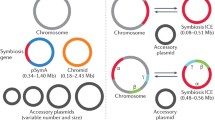Abstract
Rhizobia are a diverse group of bacteria engaged in nitrogen-fixing symbioses with leguminous plants. A prevalent interaction type results in root nodules colonized by the bacteria. Establishment and maintenance of this symbiosis involves specific recognition and coordinated differentiation of both bacterial and host cells driven by signal exchange. Characterization of this interplay reveals an impressive degree of specificity and fine-tuning resulting from million years of evolution.
Similar content being viewed by others
Literatur
Masson-Boivin C, Giraud E, Perret X et al. (2009) Establishing nitrogen-fixing symbiosis with legumes: how many rhizobium recipes? Trends Microbiol 17:458–466
Becker A (2009) Functional Genomics of Rhizobia. In: Pawlowski K (Hrsg) Prokaryotic Symbionts in Plants (Microbiology Monographs, Vol. 8). Springer, Heidelberg, 71–100
Harrison PW, Lower RP, Kim NK et al. (2010) Introducing the bacterial ‘chromid’: not a chromosome, not a plasmid. Trends Microbiol 18:141–148
Kumar N, Lad G, Giuntini E et al. (2015) Bacterial genospecies that are not ecologically coherent: population genomics of Rhizobium leguminosarum. Open Biol 5:140133
Gibson KE, Kobayashi H, Walker GC (2008) Molecular determinants of a symbiotic chronic infection. Annu Rev Genet 42:413–441
Krol E, Becker A (2009) Surface polysaccharides as fitness factors of nitrogen-fixing plant-associated bacteria. In: Ullrich M (Hrsg) Bacterial Polysaccharides: Current Innovations and Future Trends. Caister Academic Press, Norfolk, S 189–211
Becker A, Bergès H, Krol E et al. (2004) Global changes in gene expression in Sinorhizobium meliloti 1021 under microoxic and symbiotic conditions. Mol Plant Microbe Interact 17:292–303
Van de Velde W, Zehirov G, Szatmari A et al. (2010) Plant peptides govern terminal differentiation of bacteria in symbiosis. Science 327:1122–1126
Wang D, Griffitts J, Starker C et al. (2010) A nodule-specific protein secretory pathway required for nitrogen-fixing symbiosis. Science 327:1126–1129
Terpolilli JJ, Hood GA, Poole PS (2012) What determines the efficiency of N(2)-fixing Rhizobium-legume symbioses? Adv Microb Physiol 60:325–389
Charoenpanich P, Meyer S, Becker A et al. (2013) Temporal expression program of quorum sensing-based transcription regulation in Sinorhizobium meliloti. J Bacteriol 195:3224–3236
Schlüter J-P, Czuppon P, Schauer O et al. (2015) Classification of phenotypic subpopulations in isogenic bacterial cultures by triple promoter probing at single cell level. J Biotechnol 198:3–14
Rogers C, Oldroyd GE (2014) Synthetic biology approaches to engineering the nitrogen symbiosis in cereals. J Exp Bot 65:1939–1946
Author information
Authors and Affiliations
Corresponding author
Additional information
Anke Becker 1986–1994 Biologiestudium und Promotion, Universität Bielefeld. 1995–2000 Forschungsgruppenleiterin, Universität Bielefeld. 1999 Gastwissenschaftlerin, Massachusetts Institute of Technology, Cambridge, USA. 2000–2007 Hochschuldozentin, Universität Bielefeld. 2008–2011 Professorin für Systembiologie der Prokaryoten, Universität Freiburg. Seit 2011 Professorin für Vergleichende Genomik von Mikroorganismen, Universität Marburg.
Rights and permissions
About this article
Cite this article
Becker, A. Knöllchensymbiose — wenn Pflanzen und Bakterien sich verstehen. Biospektrum 21, 151–153 (2015). https://doi.org/10.1007/s12268-015-0551-5
Published:
Issue Date:
DOI: https://doi.org/10.1007/s12268-015-0551-5



